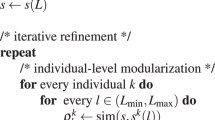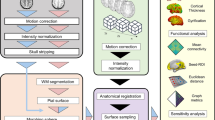Abstract
Recently, resting-state functional magnetic resonance imaging has been used to parcellate the brain into functionally distinct regions based on the information available in functional connectivity maps. However, brain voxels are not independent units and adjacent voxels are always highly correlated, so functional connectivity maps contain redundant information, which not only impairs the computational efficiency during clustering, but also reduces the accuracy of clustering results. The aim of this study was to propose feature-reduction approaches to reduce the redundancy and to develop semi-simulated data with defined ground truth to evaluate these approaches. We proposed a feature-reduction approach based on the Affinity Propagation Algorithm (APA) and compared it with the classic featurereduction approach based on Principal Component Analysis (PCA). We tested the two approaches to the parcellation of both semi-simulated and real seed regions using the K-means algorithm and designed two experiments to evaluate their noiseresistance. We found that all functional connectivity maps (with/without feature reduction) provided correct information for the parcellation of the semisimulated seed region and the computational efficiency was greatly improved by both featurereduction approaches. Meanwhile, the APA-based feature-reduction approach outperformed the PCAbased approach in noise-resistance. The results suggested that functional connectivity maps can provide correct information for cortical parcellation, and feature-reduction does not significantly change the information. Considering the improvement in computational efficiency and the noise-resistance, feature-reduction of functional connectivity maps before cortical parcellation is both feasible and necessary.
Similar content being viewed by others
References
Stephan KE, Kamper L, Bozkurt A, Burns GA, Young MP, Kötter R. Advanced database methodology for the Collation of Connectivity data on the Macaque brain (CoCoMac). Philos Trans R Soc London B Biol Sci 2001, 356: 1159–1186.
Kotter R. Online retrieval, processing, and visualization of primate connectivity data from the CoCoMac database. Neuroinformatics 2004, 2: 127–144.
Brodmann K. Vergleichende Lokalisationslehre der Großhirnrinde in ihren Prinzipien dargestellt auf Grund des Zellenaufbaues. Leipzig: Barth, 1909.
Talairach J, Tournoux P. Co-planar stereotaxic atlas of the human brain: 3-Dimensional proportional system—An approach to cerebral imaging. New York: Thieme, 1988.
Vogt O. Die myeloarchitektonische Felderung des menschlichen Stirnhirns. J Psychol Neurol 1910, 15: 221–232.
Vogt O. Die Myeloarchitektonik des Isocortex parietalis. J Psychol Neurol 1911, 18: 379–390.
Zilles K, Amunts K. Receptor mapping: architecture of the human cerebral cortex. Curr Opin neurol 2009, 22: 331–339.
Tzourio-Mazoyer N, Landeau B, Papathanassiou D, Crivello F, Etard O, Delcroix N, et al. Automated anatomical labeling of activations in SPM using a macroscopic anatomical parcellation of the MNI MRI single-subject brain. Neuroimage 2002, 15: 273–289.
Roland PE, Zilles K. Structural divisions and functional fields in the human cerebral cortex. Brain Res Brain Res Rev 1998, 26: 87–105.
Passingham RE, Stephan KE, Kotter R. The anatomical basis of functional localization in the cortex. Nat Rev Neurosci 2002, 3: 606–616.
Margulies DS, Kelly AM, Uddin LQ, Biswal BB, Castellanos FX, Milham MP. Mapping the functional connectivity of anterior cingulate cortex. Neuroimage 2007, 37: 579–588.
Kim JH, Lee JM, Jo HJ, Kim SH, Lee JH, Kim ST, et al. Defining functional SMA and pre-SMA subregions in human MFC using resting state fMRI: Functional connectivity-based parcellation method. Neuroimage 2010, 49: 2375–2386.
Barnes KA, Cohen AL, Power JD, Nelson SM, Dosenbach YB, Miezin FM, et al. Identifying Basal Ganglia divisions in individuals using resting-state functional connectivity MRI. Front Syst Neurosci 2010, 4: 18.
Nelson SM, Cohen AL, Power JD, Wig GS, Miezin FM, Wheeler ME, et al. A parcellation scheme for human left lateral parietal cortex. Neuron 2010, 67: 156–170.
Cauda F, D’Agata F, Sacco K, Duca S, Geminiani G, Vercelli A. Functional connectivity of the insula in the resting brain. Neuroimage 2011, 55: 8–23.
Deen B, Pitskel NB, Pelphrey KA. Three systems of insular functional connectivity identified with cluster analysis. Cereb Cortex 2011, 21: 1498–1506.
Craddock RC, James GA, Holtzheimer PE 3rd, Hu XP, Mayberg HS. A whole brain fMRI atlas generated via spatially constrained spectral clustering. Hum Brain Mapp 2012, 33 (8): 1914–1928.
Zhang S, Ide JS, Li CS. Resting-state functional connectivity of the medial superior frontal cortex. Cereb Cortex 2012, 22 (1): 99–111.
Cohen AL, Fair DA, Dosenbach NUF, Miezin FM, Dierker D, Van Essen DC, et al. Defining functional areas in individual human brains using resting functional connectivity MRI. NeuroImage 2008, 41: 45–57.
van den Heuvel M, Mandl R, Pol HH. Normalized cut group clustering of resting-state fMRI data. PLoS One 2008, 3: e2001.
Shen X, Papademetris X, Constable RT. Graph-theory based parcellation of functional subunits in the brain from restingstate fMRI data. Neuroimage 2010, 50: 1027–1035.
Zhang DY, Snyder AZ, Fox MD, Sansbury MW, Shimony JS, Raichle ME. Intrinsic functional relations between human cerebral cortex and thalamus. J Neurophysiol 2008, 100: 1740–1748.
Biswal B, Yetkin FZ, Haughton VM, Hyde JS. Functional connectivity in the motor cortex of resting human brain using Echo-Planar MRI. Magn Reson Med 1995, 34(4): 537–541.
Margulies DS, Vincent JL, Kelly C, Lohmann G, Uddin LQ, Biswal BB, et al. Precuneus shares intrinsic functional architecture in humans and monkeys. Proc Natl Acad Sci U S A 2009, 106: 20069–20074.
Zhang S, Li CS. Functional connectivity mapping of the human precuneus by resting state fMRI. Neuroimage 2012, 59(4): 3548–3562.
Yeo BT, Krienen FM, Sepulcre J, Sabuncu MR, Lashkari D, Hollinshead M, et al. The organization of the human cerebral cortex estimated by intrinsic functional connectivity. J Neurophysiol 2011, 106: 1125–1165.
Power JD, Cohen AL, Nelson SM, Wig GS, Barnes KA, Church JA, et al. Functional network organization of the human brain. Neuron 2011, 72: 665–678.
Frey BJ, Dueck D. Clustering by passing messages between data points. Science 2007, 315: 972–976.
Hotelling H. Analysis of a complex of statistical variables into principal components. J Educ Psychol 1933, 24: 417–441.
Biswal BB, Mennes M, Zuo XN, Gohel S, Kelly C, Smith SM, et al. Toward discovery science of human brain function. Proc Natl Acad Sci U S A 2010, 107: 4734–4739.
Cox RW. AFNI: Software for analysis and visualization of functional magnetic resonance neuroimages. Comput Biomed Res 1996, 29: 162–173.
Smith SM, Jenkinson M, Woolrich MW, Beckmann CF, Behrens TE, Johansen-Berg H, et al. Advances in functional and structural MR image analysis and implementation as FSL. Neuroimage 2004, 23: S208–S219.
Fox MD, Snyder AZ, Vincent JL, Corbetta M, Van Essen DC, Raichle ME. The human brain is intrinsically organized into dynamic, anticorrelated functional networks. Proc Natl Acad Sci U S A 2005, 102: 9673–9678.
Van Essen DC. A Population-Average, Landmark- and Surface-based (PALS) atlas of human cerebral cortex. Neuroimage 2005, 28: 635–662.
Paxinos G, Mai JK. The Human Nervous System (2nd ed.). San Diego: Elsevier Academic Press, 2004.
Author information
Authors and Affiliations
Corresponding authors
Additional information
These authors contributed equally to this work.
Rights and permissions
About this article
Cite this article
Tian, X., Liu, C., Jiang, T. et al. Feature-reduction and semi-simulated data in functional connectivity-based cortical parcellation. Neurosci. Bull. 29, 333–347 (2013). https://doi.org/10.1007/s12264-013-1339-6
Received:
Accepted:
Published:
Issue Date:
DOI: https://doi.org/10.1007/s12264-013-1339-6




